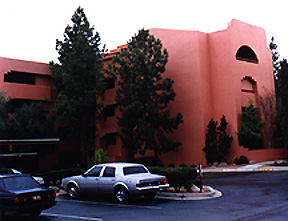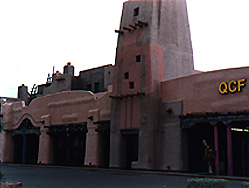
SOUTHWEST CULTURE AESTHETICS PUZZLES
These buildings are located in the Phoenix Arizona area. Please discuss the following puzzling questions and give good reasons.
* Which work is authentic? {genuine, conforming to the original style and materials)
* Which work is kitsch? (pretentious bad taste; put together fast & sloppily)
* Which work is Nouveau Pueblo? (an imaginative Southwest Style)
* Which one is beautiful and why?
* Which work is the best and why?
* What are the functions of these buildings?


Believe It or Not?
The following scene came from Woodson's class in which he told a story about the Southwest mountain men who lived in Arizona a long time ago. He described how they didn't take baths nor shaved. He reminded students that no white women were around then, so the men had to appeal to the Native American women, who valued different standards of beauty.
a. What different things did these men have to do to attract women?
b. Do you believe this story? Why or why not?
c. How would you change it?
c. What aesthetic issue is the teacher addressing here?
d. How does it compare it with today's standards?
IS THIS HOUSE A WORK OF ART?
Students [Tavan Elementary, Instructor Darlene Ritter, Scottsdale, 2/7/07] discuss the model house [architecture] as art.

T, "Is this house art?"
S, "Yeh, kind of."
T, "Why?"
S, "How they made it."
T, "How's that?" S, "Designed it"
T, "I can design a bathtub. Is it art? My job is to give you contrary arguments."
T, "What kind of art is this?" S, "Design house [architecture]."
T, "Is every house art? What makes the house stand out?" S, "Style?"
T, "What is style?"
S, "The way you do something."
T, "In those days, did they have style?"
T, "Did they [Native Americans] think that it [house] was art?
S, "It was work for them."
T, "Is art work?" S, "Yes."
T, "Where did art come from?"
S1, "They did art, but didn't call it that [art]."
S2, "We introduced it."
T, "Yes, we introduced the term in 19th century. Anything else here [in the model] art?"
S, "Pots."
T, "Good, houses are not always art, why"?
S, "Way of life."
Although students didn't know all the answers, they carried on a short discussion at the beginning of their studio class. Such a discussion does not have to be long nor perfect in the beginning.
WHAT QUESTIONS WOULD YOU ADD TO HELP STEER STUDENTS TO UNDERSTAND ARCHITECTURE AS ART?
Put on home page:
Special thank you to Larry Woodson, lead teacher from Fees Intermediate School in Tempe; Darlene Ritter from Tavan Elementary in Scottsdale; Barbara Weeks from Creighton Elementary School; Joyce Batchelor from Gila Bend Unified School in Gila Bend, and graduate students--Laurie Black and Julie Lawson.
New page--